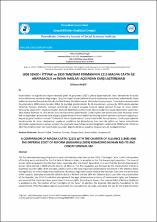| dc.contributor.author | Başcı, Gülistan | |
| dc.date.accessioned | 2021-11-01T18:19:14Z | |
| dc.date.available | 2021-11-01T18:19:14Z | |
| dc.date.issued | 2021 | |
| dc.identifier.citation | BAŞCI, G. (2021). 1808 Sened-i İttifak ve 1839 Tanzimat Fermanının 1215 Magna Carta ile Anayasacılık ve İnsan Hakları Açısından Karşılaştırılması" Pamukkale Üniversitesi Sosyal Bilimler Enstitüsü Dergisi, (46), 227-242. | en_US |
| dc.identifier.issn | 1308-2922 | |
| dc.identifier.issn | 2147-6985 | |
| dc.identifier.uri | https://doi.org10.30794/pausbed.803116 | |
| dc.identifier.uri | https://app.trdizin.gov.tr/makale/TkRReU5UUTBOQT09 | |
| dc.identifier.uri | https://hdl.handle.net/11491/8314 | |
| dc.description.abstract | İnsan hakları ve özgürlüklere ilişkin meydana gelen ilk gelişmeler 1200’lü yıllara dayanmaktadır. Batılı devletlerde ilk olarak kralın yetkilerinin sınırlandırıldığı Magna Carta (Hürriyet Fermanı) bilinen ilk yasal düzenleme olarak kabul edilmektedir. İnsan hakları konusu ise Osmanlı devletinde özellikle Fransız İhtilalinin sonrası dönemde ortaya çıkmıştır. İnsan hakları konusundaki ilk gelişmelerin 1808 yılında Senedi-i İttifak ile başladığı görülmektedir. Bu ilk düzenlemeyi sonrasında 1839 yılında çıkarılan Tanzimat Fermanı izlemiştir. Osmanlı devletinde en önemli anayasa hareketi olarak görülen ferman ile insan hakları konusunda yasal zemin oluşturulmuştur. Osmanlı devletinde cumhuriyetin ilanına kadar çok sayıda düzenleme yapılmıştır. 1856 Islahat Fermanı ve 1876 Kanuni Esasi bunlara örnek gösterilebilir. Cumhuriyetin ilanı sonrasında 1924 Anayasası temel hak ve özgürlükler anlamında yasal altyapıyı güçlendirmiş ve insan hakları konusunda önemli adımların atılmasını sağlamıştır. Kapani’ye göre Tanzimat Fermanı “Türklerin İlk Haklar Beyannamesi” olarak kabul edilir. Ayrıca Ferman, Cumhuriyet rejiminin kurulmasında bir temel oluşturmuş, yapılacak yeniliklere hız kazandırmış, batı tarzında eğitim ve hukuk sistemlerinin ülkemizde uygulanmasının yolunu açmıştır. Bu çalışmada insan haklarının tarihsel gelişimi incelenerek, 1808 Sened-i İttifak ve 1839 Tanzimat Fermanı’nın insan hakları açısından değerlendirilmesi yapılmış, Magna Carta ile karşılaştırılmıştır. | en_US |
| dc.description.abstract | The first developments regarding human rights and freedoms date back to the 1200s. The Magna Carta, in which the powers of the king were restricted for the first time in Western states, is accepted as the first known legal regulation. The issue of human rights emerged in the Ottoman State, especially after the French Revolution. It is seen that the first developments in human rights started in 1808 with the Charter of Alliance. This first regulation was followed by the Imperial Edict of Reform (Gulhane) issued in 1839. With the edict, which is seen as the most important constitutional movement in the Ottoman State, the legal basis for human rights was established. Numerous regulations were made in the Ottoman State until the declaration of the republic. Examples include the 1856 the Edict of Reform and the 1876 the Ottoman Basic Law. After the proclamation of the Republic, the 1924 Constitution strengthened the legal infrastructure in terms of fundamental rights and freedoms and ensured that important steps were taken in human rights. According to Kapani, the Imperial Edict of Reform (Gulhane) is accepted as the "Declaration of the First Rights of the Turks". In addition, the Imperial Edict laid the foundation for the establishment of the Republican regime, accelerated the innovations to be made, and paved the way for the implementation of western-style education and legal systems in our country. In this study, by examining the historical development of human rights, 1808 the Charter of Alliance and 1839 the Imperial Edict of Reform (Gulhane) were evaluated in terms of human rights and compared with Magna Carta. | en_US |
| dc.language.iso | tur | en_US |
| dc.relation.ispartof | Pamukkale Üniversitesi Sosyal Bilimler Enstitüsü Dergisi | en_US |
| dc.rights | info:eu-repo/semantics/openAccess | en_US |
| dc.subject | Sened-i İttifak, Tanzimat Fermanı | en_US |
| dc.subject | Magna Carta | en_US |
| dc.subject | İnsan Hakları | en_US |
| dc.subject | Anayasacılık | en_US |
| dc.subject | The Charter of Alliance | en_US |
| dc.subject | The Imperial Edict of Reform (Gulhane) | en_US |
| dc.subject | Magna Carta, Human Rights | en_US |
| dc.subject | Constitutionalism | en_US |
| dc.title | 1808 Sened-i İttifak ve 1839 Tanzimat Fermanının 1215 Magna Carta ile Anayasacılık ve İnsan Hakları Açısından Karşılaştırılması | en_US |
| dc.title.alternative | A Comparison Of Magna Carta (1215) With The Charter Of Alliance (1808) And The Imperial Edict Of Reform (Gulhane) (1839) Regarding Human Rights And Constitutionalism | en_US |
| dc.type | article | en_US |
| dc.department | Hitit Üniversitesi, Sosyal Bilimler Meslek Yüksekokulu, Yönetim ve Organizasyon Bölümü | en_US |
| dc.identifier.volume | 0 | en_US |
| dc.identifier.issue | 46 | en_US |
| dc.identifier.startpage | 227 | en_US |
| dc.identifier.endpage | 242 | en_US |
| dc.relation.publicationcategory | Makale - Ulusal Hakemli Dergi - Kurum Öğretim Elemanı | en_US |
| dc.department-temp | Hitit Üniversitesi, Sosyal Bilimler Meslek Yüksek Okulu Yönetim ve Organizasyon Bölümü Yerel Yönetimler Programı, Çorum, Türkiye | en_US |
| dc.contributor.institutionauthor | Başcı, Gülistan | |
| dc.identifier.doi | 10.30794/pausbed.803116 | |


















